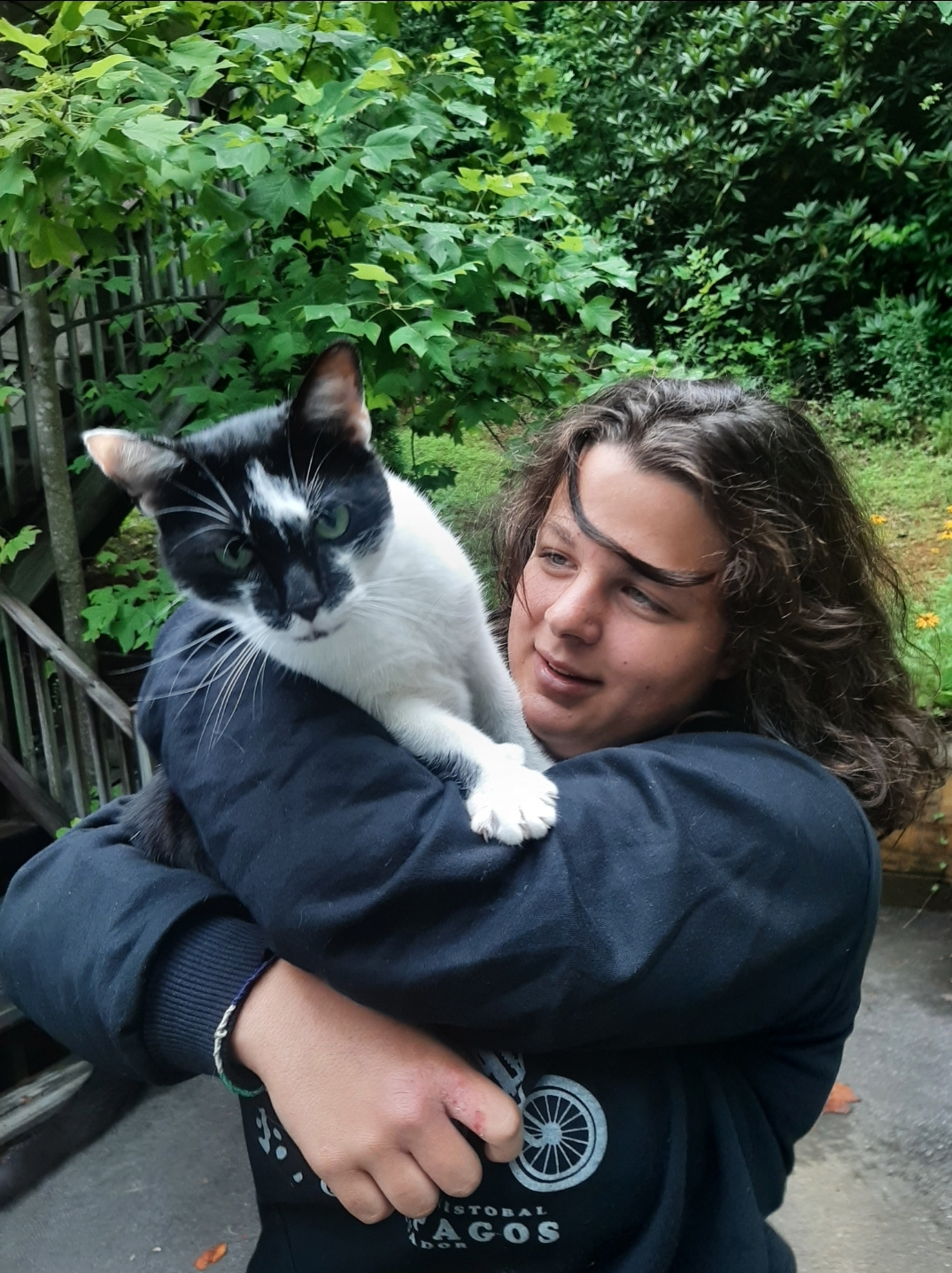Monday, July 31, 2023
Sunday, July 30, 2023
Saturday, July 29, 2023
Annie's Ecuador & Galapagos Trip 🇪🇨 2023 : A Letter from Past Me to Future Me
A Letter from Past Me to Future Me
7/29/23 Quito, Ecuador
–My favorite thing I did & people I met and experiences I had were….
I enjoyed many things, but talking with researchers at Tuputini and herping was very fun. Piranha fishing as well. I made pretty good friends with all the people, especially by the end of the last few dinners.
–The things I learned that I definitely don't want to forget …
Galapagos biodiversity and endemic species
How to catch glass frogs
How to set up a camera trap and mist net
How to catch piranhas
How to do a headstand
–A memorable or funny experience from my trip …
Dinner at the Galapagos where Gabe ate so much plain rice and popcorn and we all told our worst poop stories. Also that guy in Quito laughing at Jordan.
Thursday, July 27, 2023
Annie's Ecuador & Galapagos Trip 🇪🇨 2023 : Galapagos Journal Entries
Journal 1
Compare & Comtrast Andean Mountain Rainforst & Basin Rainforest
Despite being in relatively similar places in the world, the Andean mountain cloud forest and the Amazon basin forest have many differences but also many similarities. The cloud forest was located on the precipice of a volcano, so the soil has more volcanic remains. This helps the soil be richer and slightly deeper because of silica. This may be a reason that the cloud forest grows back so quickly. Tha Amazon Basin has very thin and more peat-like soil, so things grow slower if cut down. They both have thinner (????) as for geography. The cloud forest is located on a mountain, meaning that it naturally has very steep slopes. This may make it more susceptible to mudslides. The Basin, however, is mostly flat, but that also means there are bigger rivers and streams running through it. The mountain forst had only very small and clear streams that fluctuate depending on the rain. The rain in both areas is definitely very prevalent and important to both ecosysts. Being rainforest, they both experience rain every day, but the Basin tends to be humid and hot almost the whole day and only slightly cooling at night. The cloud forest dramatically cools during the night and maintains a cooler temperature throughout the day due to its elevation. The elevation, geography, weather & geology so have an effect on the flora and fauna that live in both areas. Both may look very similar at first glance, and they definitely share many species of both plants and animals, but not everything can survive in the high elevation and the steep slopes of Alto Coca. There seemed to be more plant life growing off of other trees in Alto Coca, like bromiliads. Bothe environments have very thick and green vegetation with “new growth” taking on a browner tint. As for the fauna, with the Amazon being a river Basin, there are naturally more fishing anals and aquatic life. Both environments harbor some of the same species like walking palms, pumas, and orependollas, to name a few, but they also have their differences in geography, geology, biodiversity and weather.
Journal 2: Interesting Things
What surprised me?
There have been many things that have surprised me, but one thing that is fresh on my mind is the coriolis effect at the equator and how exact it is. The guide only had to go a few feet to the left or right of the equator and it makes a very visible difference. I honestly still can't comprehend how it works and how that specific line was even discovered in the first place, as the guide said.
What changed my perspective?
It seems silly now, but before I went on the trip, my parents told me that pretty much the only people living on the Galapagos were researchers. I had no idea it was such a popular tourist destination. And not just that, but it has quite a long and bloody human history. The idea that not that long ago people were basically either prisoners or farmers is pretty crazy as it is seen as a completely different place for only the last few decades. These islands have changed so much in such a small amount of time comparatively.
What will I research at home?
Before I went to the Amazon, I had never heard of the bullet ant. I was surprised to learn that their bite was the worst feeling venom in the world. That and the fact that I only ever saw then alone, unlike other ants which I mostly see in groups. I wanted to learn more about them for my species presentation, but there was no information at Tiputini about them. This makes sense because studying the ants would mean you have to get close to themand researchers are more likely to get bitten, but I still want to learn more about their behaviors at home.
—--
Leaf Cutter Ants
They prefer newer pioneer plants in secondary forests than in old tropical forests. They were selected 8 times more than shade-tolerant species. This is because it is easier to find in New forests, it is thought. There is a low density of ants in old growth forests. Parable forest hypothesis.
They remain in the nest for many years
Atta alore (???) cuts between 12% & 17% of leaf production in some forests
Originated 45-65 million years ago. Theorized that it happened to grow in their nests and they started to eat it.
Leaf cutter ants : the role of Nutrients Water, and secondary chemistry.
Journal 3: Ecotourism
Pros and Cons of ecotourism in the Galapagos and in general & some solutions for the cons.
As an ecotourist in the Galapagos, I can tell you firsthand about what the pros of ecotourism are. Seeing what different environments look like and how they work is very inspiring. In a way, I wish more people could experience and learn about foreign ecosystems because they are so fascinating. Even as an ecotourist, I realize that this knowledge comes with dangerous side effects. One of them.being habitation of local animals. In the Galapagos specifically, many animals like Darwin's Finches have become very used to people and some may even eat human food. This makes them less likely to fulfill their niches and more likely to get hurt by a car or other human-made structure. With more humans comes the increased risk of invasive species introduced. There can be very serious consequences for even a small bug (or microorganism) to be on the bottom of someone's shoe. General destruction of habitat also has an effect on the ecosystem. For people to see animals,.they have to be able to sleep somewhere, and hotels and other amenities require a lot of land that animals and plants live in.
There are no doubt very serious problems that come with ecotourism in the Galapagos and in general. Although I think it is important for people to experience different ecosystems and challenge their comfort zone, I think there could be more done to educate them about the harm they could be doing. People need to know that taking a selfie with an alpha male sealion is not okay, and sometimes strict enforcement is the only way to help these animals still feel like they live an undisturbed life. I will say, though, that the Galapagos is one ofnthe more correctly done ecotourism sites with their fairly strict rules, but it could be better.
Journal 4
Hey ladies, my name is Fred and I enjoy long flys alone on the beach. Looking for a girl who can also fly many hours into the sunset with me. I am also looking for a girl who recognizes my huge, ruby red pouch. Definitely 8 inches if I do say so myself! I love going out to eat, and by that I mean going out to my favorite sea rock and pecking the locals for dinner. Seriously, have you tried the red footed boobie at kicker rock? Absolutely amazing! While we are there we could also try one of my favorite pastimes which is trying to see if I can pick up baby chicks and throw them into the ocean. It is just like basketball but better! Speaking a better, let's talk about how I am actually the biggest species of frigate bird, the magnificent frigate bird which was also my nickname in high school. I have also been told by my Doctor that my species also can grow to be as old as 35 years old. I am not a big percher, but I would definitely love to perch with someone on the mangroves on Isabella island while we build our nest and the trees together. I have been told that my wings look super angular while I am flying. My mom told me that I kind of look like a big bat. Anyway, I am looking for a girl who loves to eat out and spend time with her special someone. Could you be her?
—-------
Abstract:
This study was interested in the vocalization of sea lions. We were specifically looking for differences based on sex. We walked along A Part of the boardwalk, listening for vocalizations from every awake sea lion found. The data suggests that males vocalize the most often, and females vocalize when either they are bothered or when their calfs are nursing. We would like to further research the vocalization throughout the day.
Background:
We were interested in the vocalizations of sea lions on the shores of the galapagos islands. Previous encounters with them have shown that the Sea Lions vocalize often, and our team investigated the links between frequency and vocalization and sex. Our hypothesis is that males vocalize more often.
We researched the physical differences between males and females and found that adult males have a drastically pronounced forehead and comparison to females. They live in colonies led by one alpha male who has the mating rights to all the females. Juveniles nurse for about 3 years and sex is almost impossible to determine.
Methods:
In order to collect our data, we walked along the boardwalk and stopped for each sea lion that was awake. We recorded the sex, and proceeded to listen for vocalizations for 2 minutes. Each minute we recorded separately as either silent, seldom 1-2 vocalizations, frequent 3-5 vocalizations, or constant 5 vocalizations and beyond. We also took note of any outside factors that may have influenced the individuals behavior. We did this for a total of 25 sea lions. Our data was collected from around 6 PM 26 40 5 PM on the 25th of July on a mostly cloud free day. We discarded any involuntary noises like sneezes coma koff's, or flatulence. We did not time sleeping individuals.
Results
Our methods showed numerically and statistically that the alpha male in the group vocalizes the most often, the beta males occasionally, and the females mostly went around their calfs. Of the 3 males recorded, all were awakened vocalizing. Of the 49 females counted, 18 were awake and only 3 were vocalizing and only when disturbed by another sea lion. Of the juveniles counted, only 4 out of the 11 were awake, and only 2 vocalized, and both were trying to nurse. The graph to the right illustrates this Stark difference in behavior among sexes and ages.
Discussion:
The reason why we think the results showed that male sea lion is vocalized more is because they are trying to assert dominance when they are around other sea lions. Sea lions are almost always ruled by a single dominant male, which means that dominant male has the right to make as much noise as he wants to keep off other mates. As for other males, in our study we observed that even from a young age males start asserting dominance over other members of the colony by vocalizing. As for the females, at the time we observed most seem to have been sleeping. Our results are an example of how female's mostly only vocalize when annoyed or stressed. For example, typically both the baby and the mother would voice their discomfort when the baby would try to nurse. They would also vocalize when stepped on by other sea lions. We also saw that typically older babies vocalized more for nursing. We realize that this study could have been easily influenced by factors such as time of day, weather, time of year, location, etc. This leads into other questions we have now that we have this information. We would especially like to know how time of day affects the frequency of vocalizations in general and for each of the different sexes. If we were to repeat the study, we would ideally make it longer and include different times of day in our observations. We would also like to somehow find a way to tell the sex of the babies so that we could see if males vocalize more even as pups. We would also also like to have an even bigger sample size of basking sea lions and a way we could time them so that it didn't seem that we just chose the wrong moment to time them. We would like to know the difference between the vocalizations and possibly their meaning if we were to repeat the study.
In conclusion, we found that males typically vocalize more, but for seemingly different reasons than the females and pups. In the future we would like to know more about why they vocalize and how the time of day and potentially flawed methods we used affected our study.
‐—----
A Difference between El Nino & La Nina
El Nino
Less strong Tradewinds
Prevents nutrient upwelling
Warm water
Increased rain
Greater with global warming
Water doesn't mix as much
LaNina
Cooler
Dryer
Stronger Tradewinds
More nutrient upwelling (because of climate change)
BOTH make dry areas drier and wet areas wetter.
—----
Galapagos Lesson
19 islands
Never been connected to land, all oceanic
Galapagos is a fracture One between two oceanic plates
Hotspot
Area eruptions: viscosity quantity of gas

















